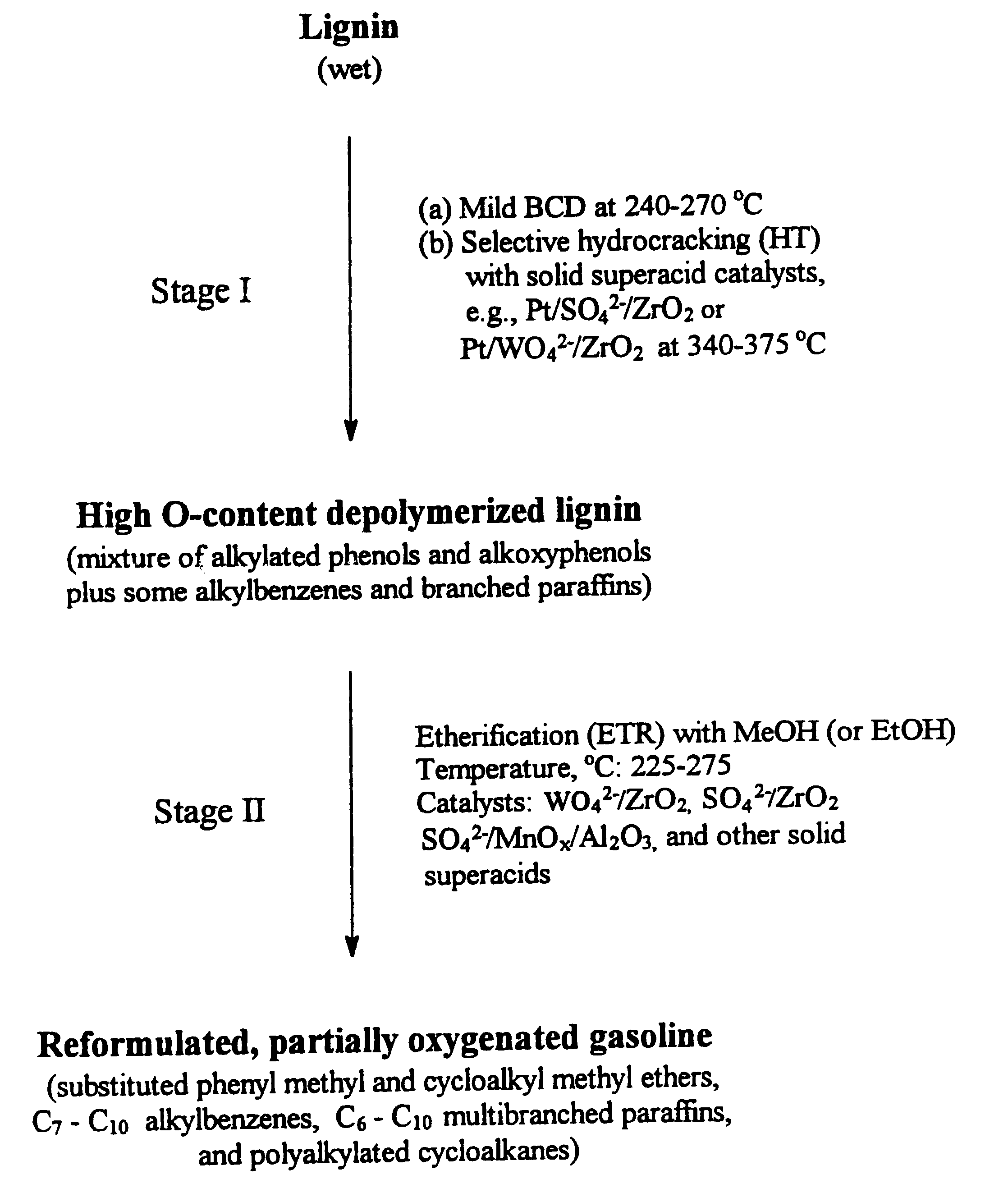Process for conversion of lignin to reformulated, partially oxygenated gasoline
a technology of lignin and gasoline, which is applied in the direction of hydrocarbon oil cracking, organic chemistry, fuels, etc., can solve the problems of limiting the overall usefulness of the process, limiting the conversion process, and no disclosure as to selective conversion of lignin into gasoline, etc., to achieve short reaction time, high fuel efficiency, and superior properties
- Summary
- Abstract
- Description
- Claims
- Application Information
AI Technical Summary
Benefits of technology
Problems solved by technology
Method used
Image
Examples
example 1
An example of runs on sequential BCD-HT treatment of a Kraft (Indulin) lignin is given in Table 3. A BCD product was first obtained at a temperature of 270.degree. C., using a 7.0 wt-% solution of sodium hydroxide in methanol as a depolymerizing agent. The BCD product was then subjected to an HT reaction under the indicated conditions, resulting in a product which was subjected to vacuum distillation to separate the monocyclic phenolic components from higher boiling oligomers. The distillation data show that under the mild HT conditions used (temperature, 350.degree. C.; H.sub.2 pressure, 1500 psig) about 30.7 wt-% of oligomers persist in the product. A gas chromatographic / mass spectral (GC / MS) analysis of the main liquid product (fraction 2) shows that the liquid includes a mixture of alkylated phenols and alkoxyphenols such as mono-, di-, and trimethylsubstituted phenols, accompanied by methylated methoxyphenols and catechols, and some alkylated benzenes and branched paraffins, as...
example 2
Table 4 below summarizes results obtained in a series of BCD-HT runs in which the MeOH / lignin weight ratio (in the BCD step) was gradually decreased from 10.0 to 3.0. The GC / MS analysis of the BCD-HT products shows that with decrease in the MeOH / lignin ratio (in the BCD step), the concentration of highly desirable mono- and dimethylsubstituted phenols (plus methoxyphenols) gradually increases, whereas that of trisubstituted (and some tetrasubstituted) phenols correspondingly decreases. It was found that at even lower MeOH / lignin ratios (e.g., 2.0) and in the presence of large amounts of water, selective formation of desirable mono-and dimethylated phenols can be achieved, with the essential exclusion of any more highly alkylated phenols. This is of major importance for optimization of the LTOG process, since it is desirable that the boiling points of the final etherified products be within the gasoline boiling range.
example 3
Following is an example of the etherification procedure used in Stage II of the process of the invention. A 5.0 g sample of a vacuum distilled BCD-HT product was subjected to etherification with 15.0 g of methanol and 2.0 g of a WO.sub.4.sup.2- / ZrO.sub.2 catalyst in a 50 cc Microclave reactor under the following conditions: reaction temperature, 250.degree. C.; reaction time, 2 hours; autogenic reaction pressure, 1200 psig; stirring rate, 500 r.p.m. The product was dried with anhydrous MgSO.sub.4 and then subjected to repeated reaction for another 2 hours. By comparison, with a feed not etherified, it was determined that the extent of the etherification of phenolic compounds in the final etherified product was 91.2 wt-%.
FIG. 3 is a graph showing the results of GC / MS analysis of a partially etherified product obtained from the phenol / methylphenol distillable fraction of the BCD-HT product at an advanced stage of etherification (.about.80 wt-%) with methanol. The exhaustive etherific...
PUM
| Property | Measurement | Unit |
|---|---|---|
| Time | aaaaa | aaaaa |
| Pressure | aaaaa | aaaaa |
| Pressure | aaaaa | aaaaa |
Abstract
Description
Claims
Application Information
 Login to View More
Login to View More - R&D
- Intellectual Property
- Life Sciences
- Materials
- Tech Scout
- Unparalleled Data Quality
- Higher Quality Content
- 60% Fewer Hallucinations
Browse by: Latest US Patents, China's latest patents, Technical Efficacy Thesaurus, Application Domain, Technology Topic, Popular Technical Reports.
© 2025 PatSnap. All rights reserved.Legal|Privacy policy|Modern Slavery Act Transparency Statement|Sitemap|About US| Contact US: help@patsnap.com



